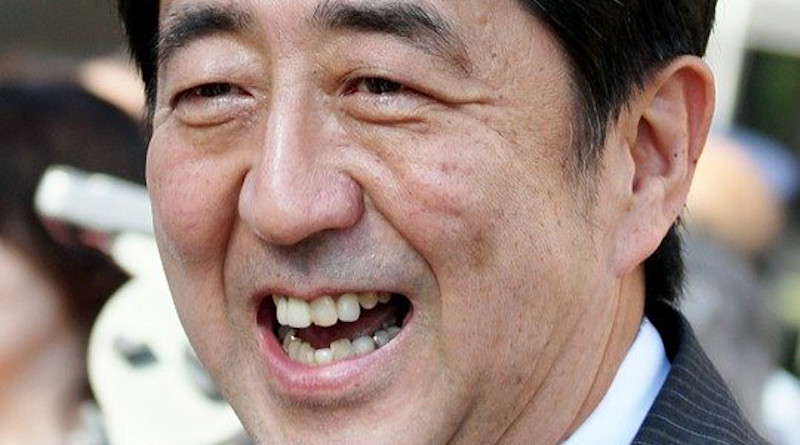Shinzo Abe: A Prime Minister Of Consequence – Analysis
By Charles E. Morrison*
Following his recent assassination, late Japanese prime minister Shinzo Abe received commendations from leaders around the world as well as a posthumous political accolade from the Japanese people: his Liberal Democratic Party’s massive victory in Upper House elections shortly after his death. The Economist and others have called him “the most consequential” Japanese prime minister of recent times, and even his numerous critics would not disagree. It is not just a matter of unprecedented longevity as prime minister, but significant accomplishments during his tenure.
First, Abe brought stability after a long period of short-term leaders, including his earlier scandal-marred stint of less than a year. In the quarter-century before his second term began in 2012, there had been 17 prime ministers, with only Junichiro Koizumi lasting more than three years. People were seeking stability, and with almost eight years in office, Abe provided it.
Economic priority, diplomatic skill
Second, from the outset, Abe prioritized economic growth. A stellar economy in the 1950s through 1980s, Japan’s GDP growth fell to almost nothing in “lost decade” of the 1990s, and the lethargy lingered with chronic deflation. Abe’s advisors formulated a “three arrow” plan of monetary easing, fiscal stimulus, and structural reforms. Critics would find “Abenomics” at best only partially successful, leaving behind huge government deficits and adding more to corporate profits than wages. But it gave hope. Measures of consumer confidence and national economic prospects rose, helping Abe maintain a strong positive approval rating during his first four years, far longer than predecessors.
Third, he presided over a deft Asia policy designed both to balance China, a regional competitor, and also to reduce the worst tensions in Sino-Japanese relations. Under Abe, Japan built regional political and economic partnerships. It lay foundations for the “Indo-Pacific” concept, prior to the American one, as well as promoted the loose “Quad” grouping with India, Australia, and the United States. Meant to protect Japan’s sea lanes and implicitly balance China, Abe’s policy also lowered the temperature around a territorial dispute with Beijing over three rocky islets. He did this by acknowledging that China claimed them, but ceding nothing in terms of Japan’s sovereignty.
Among his other achievements, Abe’s Japan assumed the leadership for implementing the previously US-led Trans-Pacific Partnership trade deal after President Trump ditched it. At the same time, Japan was a partner in the Regional Comprehensive Economic Partnership, an Asian trade initiative including China. It has also quietly promoted its own infrastructure development programs for developing Asian economies, sometimes in partnership with the United States.
Fourth, Abe was often deemed the most adept foreign leader in handling the unpredictable Trump. The importance of the US relationship to Japan can hardly be underestimated, and Abe’s efforts were designed more to contain damage rather than lay out new bilateral initiatives.
He became the first foreign leader to visit the president-elect and assiduously worked to forge a symbolic personal relationship around golf, hamburgers, matching outfits, and many meetings. While Japan did not escape criticism over trade surpluses or defense burden-sharing, Trump perceived Abe as a positive, compatible leader. If not for Abe, Trump-Japan relations undoubtedly could have mirrored those with Angela Merkel or some other G7 partners.
Push for constitutional change
Abe was often perceived more favorably abroad than at home. During his last three years, his popularity fell, with approval ratings hovering around 50 percent. His tenure was rocked by periodic scandals, and some saw him as a would-be authoritarian. His continuation in office may have reflected less his abilities than the lack of the alternatives in the opposition or his own party.
Most Japanese prime ministers try to reflect, rather than lead, consensus. Like Yasuhiro Nakasone or Koizumi before him, Abe projected a nationalistic vision of a Japan as a more “normal” country. Pushing for this vision, he made changes in coordination by creating a national security council, interpretation of the constitution, and defense spending that expanded Japan’s security role.
Some believe his most lasting legacy, based on his party’s new Diet majority following the recent election, will be the realization of his long-desired amending of the restrictive postwar constitution. Not just his nudging, but generational change, uncertain geopolitical terrain, and US pressures have been pushing Japan in this direction. When it happens, he’s likely to get the credit—or in some eyes, the blame.
*About the author: Charles E. Morrison, Senior Adjunct Fellow, East-West Center

